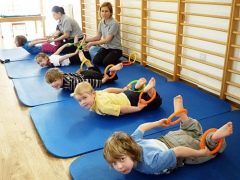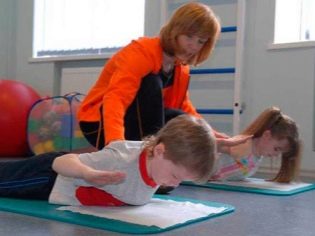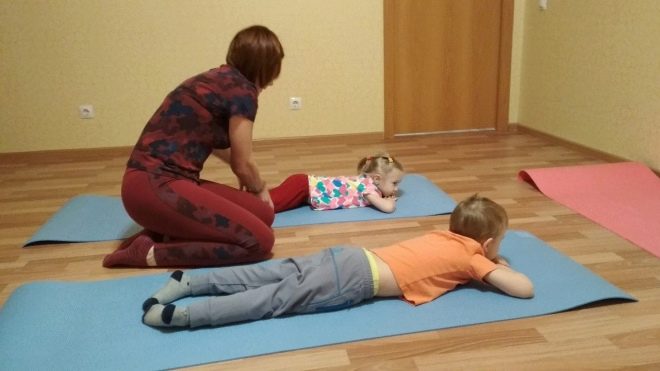What groups of exercise therapy for children and how is the lesson?
Exercise is necessary for a growing body. It allows children to grow and develop, strengthens muscles and the skeleton, and also promotes recovery from a variety of ailments. For physical education to be useful, it must be adequate, corresponding to the capabilities of the particular child. In this article we will describe which health groups for physical therapy classes exist, as well as how the classes are conducted.
Physical culture - the usual and therapeutic
Physical education in general - the concept is quite broad. Its goal is to improve physical development, strengthen the immunity of the baby or teenager. This is not about professional sports and not about the conquest of Olympic heights. Just every karapuzu regardless of age, gender, state of health, need physical exercise. Naturally, kids and teenagers need it in a different volume.
Physical therapy (exercise therapy) for children is indicated in the presence of certain health problems. It is a special complex of exercises that lead to a tone or relax completely specific muscle groups, joints, body parts. Exercise therapy for children is prescribed not only for the treatment of existing problems and ailments, but also for the prevention of the disease, if, according to the doctors, the child has a predisposition for it.
The complex of exercise therapy is made up of sports-applied, gymnastic and game exercises. In medicine there are several dozens of various recommended complexes that are prescribed for the rehabilitation of disabled children, for recovery from injuries, for rehabilitation after operations.
Medical gymnastics implies the existence of separate training programs for toddlers and adolescents with respiratory ailments, for children with impaired motor functions, for children with kidney diseases and other organs, as well as for children with neurological disorders.
In each of these groups, they take into account not only the established diagnosis, but also the age, degree and severity of the disease, and concomitant diseases. Only with all of the above, the doctor may prescribe specific exercises for the child. The most important is the physical education group of the child or the group on exercise therapy, we will tell about them below.
Most often, physical therapy classes are included in the complex treatment - they are combined with a visit to the physiotherapy room, massage, swimming in the pool, breathing exercises, auxiliary and alternative methods of treatment, as well as taking medications according to the scheme prescribed by the doctor.
The effectiveness of physical therapy depends on how appropriate the selected load was. The popular opinion that a sick baby should be more at rest is erroneous. Children with diseases need physical education even more than children without health restrictions, but this should be a completely different physical education.
Health groups
All children can be divided into five groups. Children's doctors are engaged in this division. Let's talk more about what guys belong to these groups and what physical loads they are shown.
First (group A)
This group includes healthy children who do not have any chronic diseases. The physical and psychological development of the representative of the first group fully corresponds to his age. There are no significant restrictions for him, except for age.
Gymnastics exercise therapy is carried out at the request of the parents and only for preventive purposes. The recommended exercises include fortifying sets of exercises, training with sports equipment, general physical culture.
Second (group B)
To this group, the pediatrician will attribute the generally healthy child, but having a slight lag in height, weight, and physical development from the reference age standards and standards. This group will include children who suffer from colds and viral illnesses more than 3-4 times a year, as well as children with minor speech disorders.
The criteria of this group are rather blurred and imprecise, and therefore it raises the most questions. Exercise for children of this group is recommended general, tonic, with sports equipment and without them. It is recommended to add breathing exercises to it.
Third (group C)
These include children who have chronic diseases, but they do not greatly interfere with life, that is, they are in a fully compensated state. Exacerbations in such children are rare, and the child’s state of health is normal in remission.
Usually, the third physical education group is given to children with chronic bronchitis, with the kidneys omitted, with a curvature of posture, if it does not cause other disorders in the body. Physical activity such children are shown therapeutic, standards for ordinary physical education classes are reduced.
Fourth (group D)
This group is designed for children with chronic diseases in a state of subcompensation. If a baby often suffers from exacerbations, he recovers long after them, his state of health suffers, he is shown certain narrowly targeted therapeutic exercises. This group most often includes children with bronchial asthma, with milder forms of cerebral palsy.
Fifth (group E)
This group is for children with severe illnesses that are chronic in nature - with HIA (disabilities) who cannot, due to illness, attend kindergarten or school. For them, group exercises are rarely carried out; more often, these are individual lessons with individual assignments relative to the recommended complex.
In the first group, there are usually no more than a quarter of the total number of all children: according to statistics from the Ministry of Health, the number of perfectly healthy children is at the level of 20-25%. The problem is that children are often in the first group not because they are healthy, but because they have not yet been diagnosed, because some diseases have an unexpressed and slow course.
Children from the third and fourth groups are often combined into one group for physical education, they have quite similar physical activity programs. This combined group is called "special."
Quite often, parents are interested in specific diagnoses. It is quite difficult to say to which group the child will be assigned with a compression fracture of the spine, because the consequences of the injury may be different. No less difficult to predict and group determination after pneumonia. In spastic diplegia, hemiparesis, in case of distortion, the group is established and can be changed during life.
In addition to general health, exercise therapy specialists pay special attention to types of diseases. So, children with respiratory diseases usually fall into one group for classes, and children with motor disabilities - into another.
As for infants, for them the division is not made. The only thing is that for premature babies exercise therapy is recommended to be administered later than for children born at term. The first division into groups occurs at preschool age, when the child begins to attend kindergarten, where gymnastics and physical culture are provided.
Training program
Classes can be group and individual.For children from the special group (this is the third and fourth health groups), it is advisable to conduct classes under the supervision of a specialist using heart rate monitoring, changes in blood pressure and other diagnostic markers of the child’s condition. But the main criterion is the state of health of the student himself, how he transfers the load.
For beginners, the exercises are most often simple and dosed. As the task progresses for the patient become more complicated, the load increases.
Children from the group of cardiorespiratory ailments are recommended programs based on cyclic exercises with small respiratory loads.
Children after injuries or diseases of the musculoskeletal system are additionally advised to include in swimming, gymnastics in the pool. The main complex for them includes exercises with a ball, gymnastic sticks, exercises with a gymnastic wall.
Occupation physical therapy is divided into three consecutive stages:
- introductory;
- main;
- the final one
The prologue includes warm-up, walking, running, breathing techniques. In the main part, there are always exercises recommended for a particular pathology, games, individual, with and without sports equipment.
The final part of the class always includes relaxation techniques, relaxation exercises, muscle stretching and auto-training.
Features of physical education for some diseases
With damage to the heart muscle (myocarditis) exercise therapy is recommended in the hospital, then - in the clinic at the place of residence. Only after 10 months the baby is transferred to a special group for exercise therapy, if there are no attacks. If the condition is stable and the seizures do not recur throughout the year, the child can be transferred to the third group after a year. After two years, under favorable circumstances, one can count on getting into the general physical culture group.
With congenital heart defects, the situation is more complicated: the child will be able to get a maximum of 4 group, and that provided that after the operation at least 12 months have passed and the whole this year the baby has been successfully doing exercise therapy.
In bronchial asthma, boys and girls will remain in the group of exercise therapy as long as frequent attacks recur. If the seizures do not recur within two months, they may be allowed to engage in group 4, and if there are no seizures during the year, then in the third.
In case of chronic gastritis or colitis, the child can be counted on to be transferred to the fourth fitness group from the group of exercise therapy only for half a year in the absence of exacerbations. Physical exercises are appointed only in the absence of pain, without exacerbation.
In hemophilia, physical therapy is not prescribed, as well as no other type of exercise. But with a minor degree of illness, light and gentle exercises can be resolved only under the supervision of a specialist.
Kidney problems - the basis for the appointment of physical education only outside of attacks and acute periods. Also, there should be no concomitant pathologies of the heart. Children with pyelonephritis, glomerulonephritis and renal insufficiency cannot get into the general group of health.
With severe manifestations of endocrine pathologies, exercise therapy is recommended from the first days of the disease, and the child can get into the general group only with the mildest degrees of diabetes and only with the individual approval of the doctor.
A child with impaired posture can and should be engaged in the general gymnastics group, and a child with developed scoliosis - only in the group of physical therapy. Separate exercise therapy does not exist for children with myopia or farsightedness, they are shown classes in special groups for severe deviations or in general physical education groups, if the deviations are minor.
Where to study?
With infants, children with disabilities who are restricted in movement, and their transportation can harm the child, homework is recommended. In other cases, parents can choose - to attend group classes or engage in individual.
Classes can be held on the basis of kindergartens and schools, be sure to specify if there is a need, when applying for a child in the relevant institutions, whether there are any specialists in exercise therapy.
Tips and tricks for parents
If the child is prescribed physical therapy, such an appointment should be treated with the same seriousness as other doctor's recommendations. It does not occur to us to ignore the prescription of a medicine to a child.
There is no exercise therapy just for the legs or the back, as many people think. The complex always includes a large number of exercises aimed at a variety of muscles, joints, ligaments, and nerve endings.
Exercise exercises are always time consuming. It is important for parents to ensure that their son or daughter does not miss them.
On the complex exercises exercise therapy for children with cerebral palsy, see the following video.






































